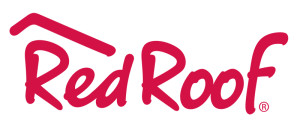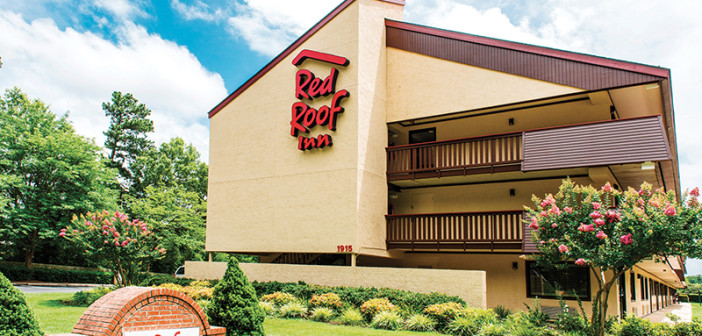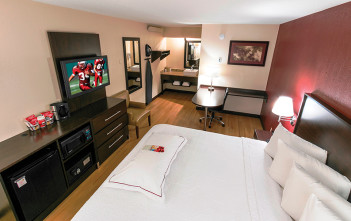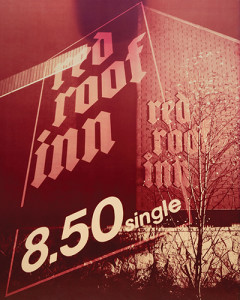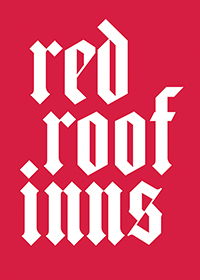COLUMBUS, OH—As he turned the key to open a small motel here in the neighborhood of Grove City back in 1972, it’s unlikely entrepreneur James R. Trueman could have imagined he would influence an Asian counterpart to essentially do the same thing in Japan 44 years later.
And he hardly could have guessed his decision early in 1973 to give his “baby” the clever, catchy name Red Roof Inn would resonate so well with guests that two decades later, investors and other hoteliers would be clamoring for their own Red Roof Inn experience as the closely held economy brand grew.
Or that the simple name on his nugget of a motel business would one day run across the ticker at the New York Stock Exchange. Or that his “baby” would have a sibling: Red Roof PLUS+. Or that more than 400 locations, both domestic and international, could boast a Red Roof product.
However, what Trueman absolutely did know as he launched what is now emerging as a global lodging brand, was that he wanted to provide a “clean, comfortable room at a fair price,” which he tagged at $8.50 per night when he opened.
That ethos—even with changes over the decades to its business model, ownership, design and distribution [see timeline, opposite]—remains at the core of the brand’s operating philosophy.
Current President Andrew Alexander said meeting guest expectations—and expanding on them—is an integral part of doing business.
“Red Roof Inn is reinventing the economy lodging sector by listening to customers who continue to say they want an enhanced experience at a value price,” said Alexander. “The brand has improved upon its successful NextGen renovation program with Red Roof PLUS+. Understanding that today’s travelers desire more for less, Red Roof has perfected the formula and the brand’s bookings are benefiting. I listen to and respond to customer feedback. That, coupled with committed follow-through and execution at the hotel level, has catapulted Red Roof to another realm of guest satisfaction.”
The brand’s core customer is the traveler who is looking for value both for leisure and business, said Alexander. “Our guests are among the millions of Americans who are traveling around the country to attend enjoyable and entertaining activities while saving money by staying at an upscale-economy hotel. We’ve also been targeting families and millennials, two growing segments for us.”
And since those groups are not restricted to the U.S., the company in recent years has pushed its international expansion, bringing properties to such countries as Brazil, Canada, Thailand and Japan via development partners.
Red Roof Inn partnered with Nobile Hoteis in 2014 to develop 35-40 properties—new-builds and conversions—across Brazil over the next 25 years. Red Roof Inn opened its first international location in Curitiba on September 1, 2015, and another location in Vitoria this past April 22.
It also inked a deal with developer Glenn Squires to build 40 hotels across Canada over 20 years via Pacrim Hospitality Services Inc.
It partnered with Paragon Hotels Ltd. to open new-build hotels across Thailand between now and 2020, and is actively securing sites in major tourist locations from Bangkok to Phuket.
“Our most recent international expansion was in Japan, where we opened a PLUS+ property in the Namba area of Osaka on July 15,” said Chief Development Officer Phil Hugh.
Expanding a legacy brand to other parts of the world often brings challenges in meeting market expectations, and Alexander is intent on ensuring the brand maintains its character.
“We hope to create brand consistency and loyalty, so the strategy for international expansion is to roll out properties that deploy Red Roof’s signature NextGen or PLUS+ concepts to ensure that exterior and interior features are immediately recognizable and distinguishable from other Red Roof hotels around the world,” said Alexander.
“For example, the Red Roof PLUS+ Namba-Osaka has been updated with the standard Red Roof PLUS+ decor and amenities and is marketed to domestic, foreign, business and leisure travelers,” he continued. “Also, the first set of hotels in Thailand will have standard Red Roof signage, roofing and room topography. We believe upholding Red Roof’s high hotel standards will be the key to winning guests’ hearts and minds in other regions.”
Alexander stressed Red Roof “is always seeking the right international partners with deep local knowledge for the brand’s expansion globally” and Hugh said Red Roof Inn would be opportunistic as it uncovers global deals.
“We still have great opportunity for expansion throughout the United States,” Hugh added. The company will continue to focus on expanding via conversion and new-construction in markets where the financial model makes the most economic sense. “In this segment, you can still purchase significantly below what a new-build would cost, so our brand will continue to be weighted toward conversions,” said Hugh.
According to the chief development officer, Red Roof’s business continued to grow exponentially in 2016, reaching more than 470 locations and adding 88 new franchisees, a 22% increase. With the development deals in Brazil, Thailand and Japan and a total of 69 new deals inked, the brand (at press time) was expected to have more than 500 properties by year-end 2016.
Also, the PLUS+ product, which was introduced in 2013, has seen strong traction and has opened up a guest tier for the brand. “There were 36 PLUS+ locations in 17 states by the end of 2015,” said Alexander. “We now have 48 locations, so it’s about 10% of the portfolio. We’d like to see 15-20% PLUS+ product across the country, especially as we try to position it in higher ADR locations. It’s allowed us to get a level of corporate customer that’s more upscale than economy usually enjoys.” The company expected to have 53 Red Roof PLUS+ hotels by year-end 2016.
“We are proud of our upscale-economy PLUS+ product and have been building or upgrading to more PLUS+ locations across the country,” said Hugh. “The robust health of Red Roof was fueled by continued growth for the brand, demand for upscale-economy products, and a momentum that proved Red Roof has become a major draw for guests, franchisees and investors.”
Such “magnetism” is nothing new for the brand. When Trueman passed away in 1986 his “baby” had grown to some 180 Red Roof Inns in 30 states. Via a private trust, Trueman’s family continued to oversee the company until 1993—a time when the lodging industry was in ongoing recovery from the decade’s earlier recession—when Morgan Stanley Real Estate Fund said it would acquire it for $600 million. It subsequently took the company public and put strong emphasis on growing the Midwest-centric brand.
While momentum was gained, it was Francis “Butch” Cash, a veteran Marriott executive who had taken on the role of Red Roof Inn’s president/CEO, who really turned the direction of the company with the launch of a franchise program for the brand, something neither Trueman nor the Morgan Stanley fund reportedly ever wanted to do. It opened its first franchise property in 1997 in the rapidly developing and increasingly popular destination of Branson, MO.
In July 1999, Morgan Stanley Real Estate Fund agreed to sell Red Roof Inn to France-based Accor SA for $613 million ($22.75 per share for its 68.3% stake), with Accor also assuming $502 million in debt.
Accor subsequently formed Accor Economy Lodging, which umbrellaed its Motel 6, Studio 6 and Red Roof Inn holdings, and moved Red Roof’s corporate office to its North American base in Carrollton, TX.
Eight years later, following a $250-million repositioning effort that established the brand’s first major renovation program, Accor agreed to sell the then 326-property [221 corportate-owned, 105 franchised] lodging chain to a consortium for $1.3 billion.
The 2007 transaction delivered the chain to the Global Special Situations Group (GSS) of Citigroup Global Markets Holdings Inc. and the Westbridge Hospitality Fund LP. (GSS was investing Citigroup’s capital in so-called “event-driven and special situation strategies” on a worldwide basis, while Westbridge was a partnership among Westmont Hospitality Group, a privately held owner/manager of more than 400 hotels and several Canadian pension fund managers.)
The Red Roof Inn properties had been managed by Accor North America, headed by Georges Le Mener, president/CEO, with Joseph Wheeling, who briefly led the company as CEO following the sale before stepping down for personal reasons in 2008—serving as COO of Red Roof Inn.
Alexander, a veteran lawyer with previous executive hospitality experience, had joined the company in 2007 and, with Wheeling’s departure, he began leading the company in April 2009 during what were extremely tough times for lodging as it tried to cope with the ongoing recession, plummeting rates and sluggish occupancy. Two months later, credit-rating firm Realpoint LLC reported Red Roof Inn had defaulted on four mortgage loans representing $361.4 million, collateralized by 131 Red Roof Inns.
Via a statement at the time, Alexander kept a steady hand on the situation, stressing the company was profitable from an operating standpoint and discussions were under way with lenders to restructure the debt, which at the height of the downturn, could only be expected to take time.
In 2011, Alexander was named president officially and affiliates of Westmont Hospitality Group and Connecticut-based Five Mile Capital Partners snapped up 143 Red Roof Inns by purchasing $700 million of Red Roof Inn debt and poured in another $70 million for renovations to include the chain’s signature NextGen or PLUS+ designs. Westmont did a similar JV with New York-based Dune Real Estate partners, acquiring 51 Red Roof Inns and infusing $20 million for upgrades.
In 2015, Five Mile sold its majority stake to Singapore-based Bestford Capital, who partnered with Westmont Hospitality to acquire a portfolio of 89 Red Roofs for $600 million, according to tracking group Commercial Mortgage Alert. Westmont continued to operate the chain.
One aspect helping fuel Red Roof’s expansion, Alexander indicated, is a lack of confusion around what the company entails. “Our one-brand, one-focus strategy is an advantage. It allows us to be nimble and implement strategies that will propel us further ahead of our competition, but only if we embrace it and live it.” he said. “While our competition implements strategies that help one brand but hurt another, we can remain focused on what makes our brand great—and profitable.”
As it heads toward the half-century mark, Alexander cited the brand’s NextGen renovation program as transformative. “NextGen renovated properties encourage repeat visitation with guests awarding upgraded properties the highest scores. Repeat guests, judicious and discerning,
come with expectations set from their previous stays. We found first-time guests were ‘wowed’ by their experience at the Red Roof NextGen properties and wanted to share their ‘new find’ on social media,” he said. “As a result of the combination of the new offering and our strategic positioning as an upscale-economy hotel brand, Red Roof experienced double-digit growth. PLUS+ has really wowed guests as well, and is once again transforming the brand perception and experience among travelers.”
With so many hotel brands emerging since Red Roof Inn was founded, Alexander was asked how the company alerts guests—and potential developers/owners—that this is a brand with roots, one that is maintaining its DNA while still looking to the future.
“Red Roof’s consistency and safe, comfortable and convenient hotels have resonated with travelers, franchisees and investors for years and that has not changed. It’s a trusted, recognizable brand that developers want to align and work with, and investors believe in. Our DNA is infallible and the future is bright for Red Roof.” HB
1972 James R. Trueman opens a motel in the Grove City neighborhood of Columbus, OH, “to provide a clean, comfortable room at a fair price.”
1973 Motel is officially named Red Roof Inn on Feb. 20, with a single-room rate of $8.50.
1982 Installs first computer system for reservations management and introduces RediCard, a guest ID card to save time in registering/making reservations through toll-free number
1984 Connects all PMSs to corporate office
1988 Launches television/radio ad campaign; TV ads feature comedian Martin Mull.
1992 Introduces toll-free number using a telecommunications device for hearing-impaired persons, which become available at all hotels
1994 Morgan Stanley Real Estate Fund, LP purchases Red Roof Inn from Trueman Family.
1996 Launches IPO at $16 per share and trades on NYSE under symbol RRI
1997 Opens first franchise property in Branson, MO
1999 France-based Accor purchases all outstanding shares of Red Roof Inn; it subsequently groups Red Roof Inn, Motel 6 and Studio 6 to form Accor Economy Lodging (AEL).
2000 Moves corporate office to Dallas; introduces points-based loyalty program; relaunches RediCard program as RediCard Preferred Member; promotes internet discount program with Red Hot Deals online; unveils “Red,” the bobble-head road warrior, as “spokesperson”
2003 Initiates $250-million repositioning effort via first major renovation program
2006 Offers upgraded bedding package; J.D. Power rates the brand number one in bedding comfort.
2007 Announces redesign via NextGen. Westmont Hospitality Group purchases the brand and moves corporate office back to Columbus, OH.
2008 Launches All-Inclusive King Room, adding high-speed internet, unlimited local/long-distance phone calls, and outbound/inbound fax service
2009 Locust Grove, GA, property opens with NextGen room design and a modified exterior facade; partners with Great American Country and country music ambassadors Phil Vassar, Little Big Town, King Billy and Whitney Duncan. Redrooflovescountry.com showcases artists’ songs in broadband films, allowing fans to follow a tour and book a room; World Franchising Network and USA Today name brand one of “50 Top Franchises for Minorities.”
2010 Offers free WiFi, local and long distance calls, and up to 10 fax pages sent within continental U.S.
2011 Launches first mobile site for www.redroof.com; launches new PMS at both corporate and franchise-owned properties
2012 Launches updated website; launches new call center reservations system in Springfield, OH; launches YouTube videos featuring NextGen Renovations and Red Roof Luvs Pets; receives Platinum Adrian Award from Hospitality Sales & Marketing Association International (HSMAI) for the “Rediscover America Press Kit”
2013 Marks 40 years in business; introduces Red Roof PLUS+; enrolls one millionth RediCard member
2014 Named “Best Budget Hotel Brand” in USA Today’s 10 Best Readers’ Choice Awards poll; inks 39 hotel agreements, a 350% increase from 2013; announces it will open first international property in Brazil, partnering with Nobile Hoteis; earns awards for its Flight Cancellation Coup campaign, a custom-built flight-tracking tech enabled by mobile search
2015 Opens its 400th hotel in Council Bluffs, IA; opens first property in Brazil, a conversion in Brasilia; announces it is working with Paragon Hotels to break ground for first property in Thailand; launches Go More. Go Better. campaign, a brand-wide initiative incorporating a microsite, contests, social media, videos and promotion. In addition, Westmont Hospitality recapitalizes portfolio of 89 Red Roof properties.
2016 Begins test phase of Verified WiFi initiative to increase WiFi speeds to allow guests to stream movies, video games and music; opens 224-room Red Roof PLUS+/Namba-Osaka in Japan; opens second location in Brazil in Vitoria